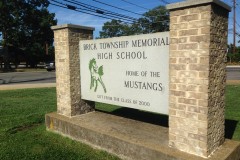Brick Township’s two high schools reached all, or a majority, of state targets for academic achievement, but lagged in the area of college and career readiness, according to the state’s School Performance Report on each school, which were released recently. Additionally, neither high school was ranked in the top half of schools statewide in a percentile ranking of three key performance areas.
The School Performance Reports measure schools statewide in three key areas: academic achievement, college and career readiness, and graduation and post-secondary performance. In each category, schools are ranked on how they meet state benchmarks, such as the number of students who take advanced placement classes, or the number of students who take the SAT exam. Schools are also ranked on graduation rate and whether students scored proficiently on standardized tests in language arts and mathematics. For each ranking, schools are given a percentile score comparing them to all schools statewide and all schools in a district’s “peer group,” which are schools the state believes serve similar grade levels and consist of student bodies with similar socioeconomic indicators.
All of the data in the reports were on the 2013-14 school year. Here’s how Brick’s two high schools school did:
|
|
Academic Achievement
Both of Brick’s high schools scored well in terms of hitting the state’s goals for high schools in terms of the percentage of students who are proficient (the state’s terminology for a passing score) on the High School Proficiency Assessment exam in language arts and literacy, and mathematics. Students are also tested in biology. At BTHS, 92 percent of students were proficient or advanced proficient in language arts and literacy, while 83 percent of students were proficient or advanced proficient in math. At BMHS, 94 percent of students were proficient or advanced proficient in language arts and literacy, while 86 percent scored similarly in math.
As for the percentages of students whose scores were considered “advanced proficient,”16 percent of BTHS students received an advanced score in both language arts and math; 6 percent scored advanced in biology.
At BMHS, 20 percent of students were considered advanced in language arts and 19 percent were considered advanced in math. In biology, 5 percent of students received advanced scores.
BTHS met 100 percent of its academic targets while BMHS met 88 percent. Despite the positive scores, students did not score as well as their peers statewide. In overall academic achievement, BTHS ranked in the 32nd percentile among its peers and the 31st percentile in the state. That means BTHS students’ scores were better than 32 percent of peer schools and 31 percent of schools statewide – conversely, 68 percent of the peer schools and 69 percent of statewide schools outperformed BTHS.
The numbers in BMHS were similar. Students’ scores were ranked in the 25th percentile of their peers and in the 41st percentile of schools statewide.
College and Career Readiness
For several years, Brick’s high schools have been punished in the category of college and career readiness, mainly for a limited number of students who take advanced placement classes and a relatively low number of students who take the PSAT and SAT exams to prepare for post-secondary education.
To the district’s credit, more advanced classes have been added since Superintendent Dr. Walter Uszenski was hired and made advanced classes a priority. Uszenski also made the PSAT exam accessible to every high school student. Still, in a highly educated and highly competitive state such as New Jersey, the increasing percentage of students taking PSAT and SAT exams is still comparably low.
BTHS met just 20 percent of state goals in the college and career readiness category, while BMHS met 40 percent of the goals – which include 80 percent participation in SAT exams, 60 percent participation in the PSAT exams, 40 percent of students scoring 1550 or higher on the SAT, 35 percent of students taking at least one AP test in English, math, social studies or science, and 75 percent of students taking AP or IB tests scoring a “3” or above.
At BTHS, 61 percent of student took the SAT exam, 68 percent took the PSAT, 35 percent scored above 1550 on the SAT and 18 percent of students tested in at least one AP test in the ranked subjects. In all, 72 percent of students who took an AP or IB test scored a 3 or above.
At BMHS, 64 percent took the SAT, 63 percent took the PSAT, 34 percent scored above a 1550 on the SAT, 15 percent of students tested in the ranked subjects and 77 percent scored a 3 or higher on those tests.
In all, BTHS ranked in the 54th percentile among its peer schools and the 43rd percentile compared to the state as a whole. BMHS ranked in the 30th percentile among its peer schools and 41st percentile statewide.
On average, 76 percent of students took the SAT statewide and 75 percent took the PSAT.
Graduation and Post-Secondary Rankings
Both of Brick’s high schools met 100 percent of their goals when it came to graduation and post-secondary rankings, but still lagged their peers and the state. At BTHS, 87 percent of students ultimately graduated and the dropout rate was 1.1 percent. At BMHS, 90 percent of students graduated and the dropout rate was 1.7 percent.
Overall, BTHS was ranked in the 34th percentile among its peer schools and the 24th percentile statewide; BMHS ranked in the 18th percentile among its peer schools and 26th percentile statewide.
At both BTHS and BMHS, 73 percent of students who graduated were enrolled in college within 16 months. At BTHS, 56.2 percent of student attended a two year school while 43.8 percent of students attended a four year school. At BMHS, 55 percent attended a two year school and 45 percent attended a four year school.

Advertisement

Police, Fire & Courts
Grand Jury Indicts Point Pleasant Man, Once a Fugitive, for Attempted Murder









